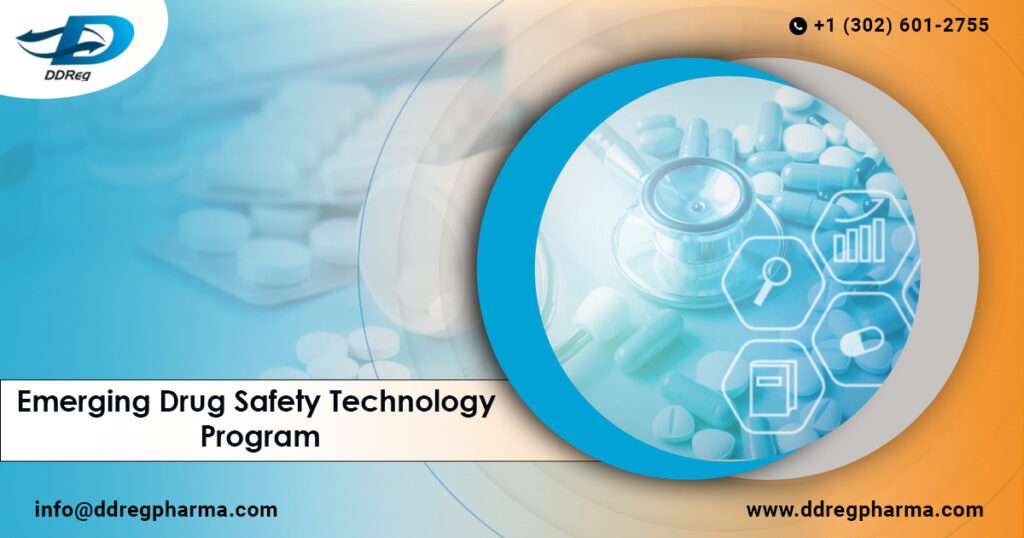Pharmacovigilance practices are associated with several challenges related to collection of safety data, processing, assessment, and volume of patient safety data. As technological disruptors- like artificial intelligence (AI)- develop, so do the solutions to tackle such challenges. This leads to more efficient pharmacovigilance (PV) systems and processes that ultimately enhance drug safety monitoring. Whether it is the automation of critical PV tasks or management of large volume of data, AI driven PV solutions are the need of the hour.
US FDA: Emerging Drug Safety Technology Program (EDSTP)
The industry and global regulators are doing their part in ensuring synergy between AI and PV for more efficient safety processes. For example, the US FDA’s Emerging Drug Safety Technology Program (EDSTP) was established to identify AI and other such technologies in PV.
The U.S. Food and Drug Administration (FDA) is leading the way in advancement across pharmaceutical safety through its Center for Drug Evaluation and Research (CDER). By establishing an Emerging Drug Safety Technology Program, CDER is forging a trail in drug safety that combines these advanced technologies and techniques to make medicines more effective and safer.
The goal of the CDER Emerging Drug Safety Technology Program is to move drug safety forward by incorporating new tools into how drugs are evaluated and monitored to protect patients as much possible. The main goals of the program include:
- Enhance Drug Safety Surveillance: CDER seeks to modernize by updating its tools and approaches through applying innovative technologies aimed at better detection of adverse drug reactions (ADRs).
- Expediting Drug Development and Approval: For drugs and treatments for HIV/AIDS and malaria developed through this initiative or improved by it in low-income countries, we must work towards streamlining the process of drug development & approval.
- Public Health: In the end, this program exists because it is part of our commitment to protecting public health by making new and existing drugs as safe and effective for human use.
The EDSTM program is not intended as a platform for obtaining regulatory advice on compliance with pharmacovigilance regulations. Instead, it aims to facilitate discussions that may inform CDER’s considerations on providing regulatory guidance for specific technologies, potentially aiding their adoption in the future. Importantly, the information exchanged during these meetings is nonbinding on both the FDA and the requesters.
Eligibility Criteria
The EDSTM program is open to applicants who have at least one approved application regulated by CDER, including New Drug Applications (NDAs), Abbreviated New Drug Applications (ANDAs), or Biologics License Applications (BLAs). Additionally, other parties involved in supporting industry PV activities, such as academia, contract research organizations (CROs), pharmacovigilance vendors, and software developers, may also participate if they meet the criteria. These entities must be working with or intending to work with AI or other emerging technologies to fulfill post-marketing reporting requirements under 21 CFR 314.80, 314.98, and 600.80. Requests for meetings can be submitted individually or in collaboration with other eligible parties.
It is important to note that while the technology discussed may have utility in both pre- and post-market PV, the EDSTM program is exclusively focused on post-market PV applications.
Submission Timeline and Process
FDA will accept and review EDSTM requests quarterly, with up to nine participants selected for the program’s initial phase each year. Submission deadlines are as follows:
- October 1, 2024
- January 1, 2025
- April 1, 2025
- July 1, 2025
CDER will respond to each meeting request within 45 days of the submission deadline.
How to Request an EDSTM
The eligible parties should submit their meeting requests via email to AIMLforDrugDevelopment@fda.hhs.gov, with the subject line “Request for an EDSTM.” CDER will confirm receipt within three business days. The request should include the following information in maximum five pages:
- Name of the requester
- Description of the organization
- Purpose of the meeting, background, and a brief description of the proposed or current use of the emerging technology for PV
- Topics for discussion
Requesters should ensure that their submissions are not tied to any regulatory application (e.g., IND, NDA, or BLA) and that the EDSTM program focuses exclusively on post-market PV technologies.
If a meeting request is granted, CDER will assign a primary point of contact within the Emerging Drug Safety Technology Program (EDSTP) to assist with scheduling and administrative details. A final meeting package must be submitted at least two weeks before the scheduled meeting date. EDSTMs will be scheduled for up to 90 minutes (about 3 hours), and follow-up meetings may be considered on a case-by-case basis. As reiterated, discussions during these meetings are nonbinding for both parties.
Conclusion
The new Emerging Drug Safety Technology Program at the CDER has undeniably taken things to a whole other level when looking out for your best interests regarding pharmaceutical products. Using AI, big data, and blockchain through wearable technologies, they are redefining drug safety.
The repercussions are high on both the pharmaceutical industry and public health, but it is a must step for the future when patients can rely with confidence that their medication prescriptions have surpassed all quality standards, including safety. With CDER leading the charge through its innovations and evolution, drug safety is enhanced, which will surely save lives both domestically and globally.
DDReg brings over 15 years of experience in pharmacovigilance including establishing robust systems to ensure compliant and efficient safety evaluation. Reach out to our experts for end-to-end pharmacovigilance services: Read more from our experts global PV experts: Leveraging Statistical Approaches in Drug Safety Analysis

